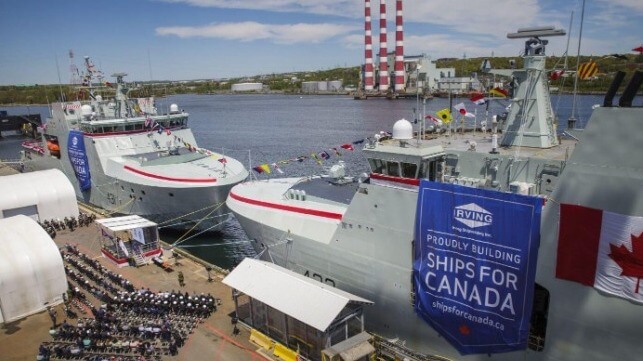Canada Names Two Arctic Offshore Patrol Ships for WWII Heroes

In a double naming ceremony at Halifax Shipyard on Sunday, the Royal Canadian Navy christened two new ice-classed patrol ships, the HMCS Margaret Brooke and HMCS Max Bernays, two WWII heroes who served with distinction at sea.
"This is a proud day for our team of over 2100 shipbuilders," said Kevin Mooney, President of Irving Shipbuilding. "From our team to the crews of these fine ships we wish you fair winds and following seas."
The ships are part of the fleet of six Harry DeWolf-class Arctic and Offshore Patrol Ships (AOPS) being delivered to the Royal Canadian Navy as part of Canada's controversial National Shipbuilding Strategy. Two more will be delivered to the Canadian Coast Guard, but supply-chain issues and inflation have doubled the price for the follow-on CCG contract.
The Arctic and Offshore Patrol Ships are ice-capable vessels measuring 340 feet long, and they are designed to conduct a variety of missions, including armed seaborne patrol and ISR. They carry a single Mk 38 25mm autocannon, the standard armament of the U.S. Coast Guard's cutter fleet.
AOPV 431 is named after Margaret Martha Brooke, a junior officer in the Royal Canadian Navy during the Second World War. Brooke enrolled as a nurse in March 1942 at the rank of Sub-Lieutenant. On October 14, 1942, she was aboard the ferry SS Caribou off Newfoundland when the vessel was torpedoed by the German submarine U-69. The ferry sank in five minutes, and Brooke abandoned ship with a friend, SLt Agnes Wilkie. Both women clung to ropes of a capsized lifeboat; despite Brooke's efforts to save her, Wilkie succumbed to the frigid water - one of the 137 lives lost that day. For her selfless act, Brooke was named a Member of the Order of the British Empire. She retired from the service in 1962 at the rank of Lieutenant-Commander and passed away at the age of 100 in 2016.
AOPV 432 is named after Chief Petty Officer (CPO) Max Bernays, a merchant mariner who was recalled to the Canadian Navy at the outbreak of the war. By March 1942, he achieved the rank of Acting Chief Petty Officer and was the coxswain aboard the destroyer HMCS Assiniboine. On August 6, 1942, during an exchange of fire with German submarine U-210 in the North Atlantic, a shell sparked a fire that engulfed the bridge and wheelhouse of Assiniboine. Surrounded by smoke and flames, CPO Bernays ordered two junior sailors to get clear, leaving him alone at the helm and trapped by the blaze. He executed helm orders and did the work of both telegraphmen at the same time. After a hard-fought exchange, Assiniboine rammed and sank U-210. For his actions, CPO Bernays was awarded the distinguished Conspicuous Gallantry Medal (CGM) by the British Admiralty.
Descendants of Lieutenant-Commander Brook and CPO Bernays were on hand as sponsors for the christening ceremony.
“It gives me great pride to think of the naval heroes these ships are being named after, and great optimism to think of the incredible capability that they are bringing to the Royal Canadian Navy, and to Canada," said Vice-Admiral Craig Baines, Commander of the Royal Canadian Navy.
